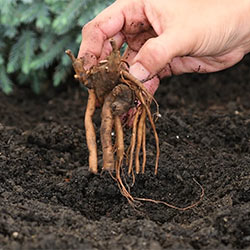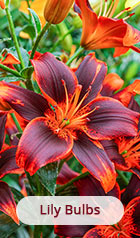Thank You!
We have received your request. You will be notified when this product is in stock.
X
They're also a supreme choice for cut-flower arrangements and wedding bouquets. You'll find everything you need for a unique and colorful tulip bulb garden, from classic red Dutch tulips to bicolored pink and purple Rembrandt, to elegant white tulips. You'll also find ruffled parrot tulips, double-blooming tulips, and Monsella tulips here! Their lush colors will ensure your flower beds or cut-flower displays will be an eye-pleasing sight for everyone. You can also expect these delightful tulip bulbs to return year after year in your garden.
How to plant tulip bulbs:
Planting tulip bulbs is a relatively easy autumn task. When planting tulip bulbs, there are just two important details to remember: plant them deep enough, and plant with the pointed ends facing up.
Choose an appropriate site for your tulip bulbs. Tulips prefer plenty of sun, and, like other bulbs, they don't tolerate soggy soil well. Consider the mature height of your tulips when selecting a location. Shorter, dwarf varieties fit well in the front of a bed or border, while taller Darwin or Triumph varieties will look great behind shorter flowers.
Break up the soil in your planting area using a shovel or trowel, and add in compost or loam to improve drainage. While fertilizing isn't always necessary for tulip bulbs, mixing a bulb-friendly fertilizer into the soil can be helpful as they start their rooting process. Be sure not to apply fertilizer directly to fresh bulbs, as it can cause burning.
Set each tulip bulb in the ground at about three times the depth of the bulb's height. So, if a bulb is around an inch tall, plant it three inches deep. Plant with the pointed end facing up, and the roots will take hold into the ground over winter! Water your tulips in once, and don't water again until they begin to sprout from the ground.
When to plant tulip bulbs:
Tulips require a period of cold to begin growing, so the best time to plant is in fall. In colder climates, like zones 3 to 5, planting should take place in September. In temperate climates, hold off until the ground has cooled completely in October. Warm zones (8 and 9) may not cool sufficiently until December. By planting in the fall, you'll allow the bulbs to take root, and to go through that necessary cold period, before blooming!
Do tulip bulbs multiply?
A true bulb, the tulip multiplies underground, naturalizing through the formation of bulblets around the parent bulb. Tulips also create seed pods through floral pollination, but seed saving is a much less common way of propagating tulips. Bulblets form all on their own, and fill out your tulip bed in a process called naturalizing. If you want to relocate some of your new tulip bulbs, dig them in fall and replant in a new spot.
When do tulips bloom?
Different varieties of tulips bloom at different times. By planting a diverse mix of tulips, you won't spend a day without color from early spring to mid summer!
Early spring tulips:
Fosteriana tulips bloom at the very beginning of spring, lighting up the ground with beautiful colors and unique, pointed flowers. Special varieties of single or double early tulips have also been hybridized to fill in the garden.
Mid spring tulips:
Classic favorites like Darwin and Triumph tulips bloom in early spring, and give you a nice, long bloom time. Greigii and other funky "species" tulips bloom in mid spring, too.
Late spring tulips:
Bright and flamboyant ruffled tulips and parrot tulips bloom in the late spring, along with some peony-type double varieties. These vibrant tulips are the perfect transition into the brighter hues of summer!
What eats tulip bulbs ?
Tulips grow from big, succulent bulbs, making them extra tasty to wildlife. Deer, gophers, rabbits, and even digging critters like voles and moles are more than happy to take a bite out of your tulip bulbs, and squirrels are liable to carry them off for safekeeping. If you're finding nibbles—or full bulbs—missing from your tulip bed, it's time to start thinking about strategies to deter the wintertime grazers.
Using a commercial-grade animal deterrent often works wonders. Spray-on, soak-on, or granular repellents use elements that are unpleasant to pests, such as spices or the scent of predator urine, to deter them from entering your garden. If you don't want to use animal repellent—say, you want to see wildlife in the garden, just not eating your bulbs—physical barriers are another good way to reduce animal grazing.
There are a few ways to physically block squirrels and other animals from getting at your tulip bulbs. One way is to lay a piece of chicken wire or garden cloth over the ground before planting. Cut through the cloth or snip a few tiny pieces of wire to create a space for planting, then spread mulch over the barrier after backfilling. Another very easy way is to purchase a bulb basket, like you will find on the Michigan Bulb site. Dig a hole large enough to bury the basket in the ground and place your tulip bulbs inside. Now, add the lid to the basket and backfill your soil covering it and protecting your tulip bulbs from hungry critters.






















